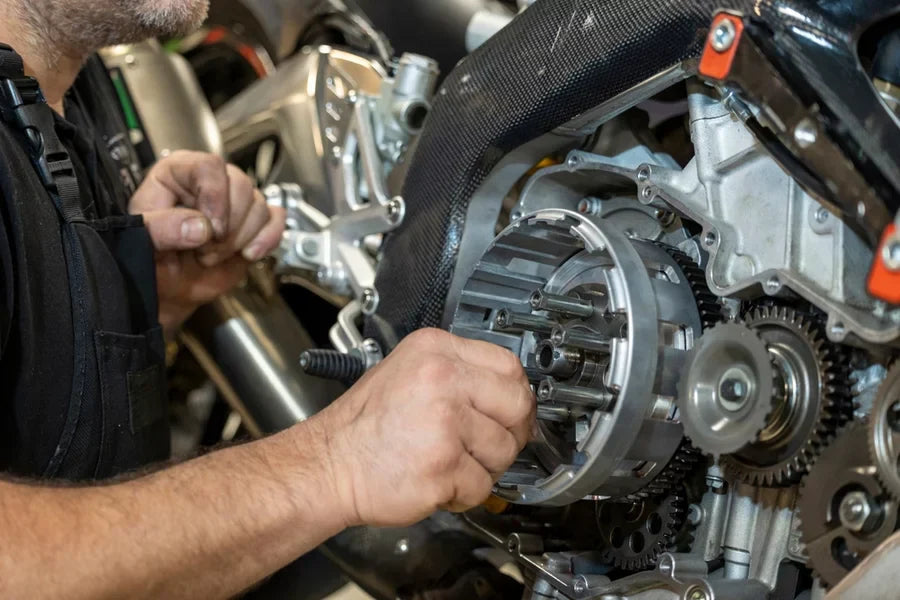TL;DR:
- Lifters, or valve lifters, connect the camshaft and valves to keep engine timing accurate.
- Harley engines often use hydraulic lifters, while some motorcycles rely on solid lifters that need adjustment.
- Bad lifters can cause ticking noises, rough idling, hesitation, misfires, and valve train damage.
- Regular oil changes help extend the life of valve lifters in motorcycles.
- Upgraded lifters are often added during performance builds for smoother operation and stronger power.
If you’ve ever asked yourself, “What are lifters on a motorcycle?”, the short answer is that they’re small parts inside the engine that help control how the valves open and close. It’s a simple job with a big impact on how your bike performs.
Most riders don’t think much about lifters until there’s a problem. A worn or noisy lifter can quickly turn into a bigger issue, and knowing the basics can help you catch signs early.
Let’s dig into exactly how lifters work, why they matter, and what to watch out for when they start to fail.
What Lifters Really Do
Inside a motorcycle engine, every part has to move in sync to keep power steady. Motorcycle lifters, also known as valve lifters or tappets, sit between the camshaft and the valves. Their job is to carry the camshaft’s motion so the valves open and close at the right moment during combustion. That precise timing is what keeps the engine efficient, reliable, and responsive when you twist the throttle.
Not all motorcycles use the same kind of lifter. Harley engines, for example, often use hydraulic lifters that adjust automatically to keep clearance just right, which helps cut down on noise and wear. Others use solid lifters that need occasional adjustment but can give riders more control in performance setups. In both cases, motorcycle engine lifters play a direct role in how smooth the ride feels, how much fuel the engine uses, and how long key components last.
Signs of Bad Motorcycle Lifters
Spotting the signs of bad motorcycle lifters early can help prevent bigger engine problems. Here are the most common indicators to look out for:
Unusual Ticking or Tapping Sounds
One of the first signs of trouble is a consistent ticking or tapping sound from the top of the engine. The noise often gets more noticeable as the engine warms up or when you accelerate.
Rough Idling or Hesitation
Failing lifters can throw off valve timing, which makes the engine idle unevenly. You may also notice hesitation or sluggish response when rolling on the throttle.
Misfires and Poor Performance
When lifters stick or wear down, combustion becomes less efficient. This can lead to misfires, reduced power, and an overall drop in performance.
Risk of Valve Train Damage
Ignoring lifter problems can cause wear on the camshaft, pushrods, and other parts of the valve train. Addressing lifter issues quickly helps avoid more costly repairs down the road.

Maintenance and Replacement
Keeping valve lifters in motorcycles in good shape really comes down to consistent care. Regular oil changes with the right grade of oil go a long way in keeping lifters lubricated and working as they should. Neglecting oil changes is one of the quickest ways to shorten their lifespan.
When it’s time for replacement, the cost depends on the motorcycle and the type of lifters it uses. On average, you can expect to spend a few hundred dollars, and Harley models are often on the higher end since the job takes more labor. Many riders also choose to swap lifters when doing a camshaft upgrade, since the engine is already opened up.
Replacing lifters before they cause more problems is a smart move. With the right parts and a little attention to maintenance, you can keep your motorcycle running smoothly and avoid bigger repair bills down the line.
Performance Upgrades
For riders looking to get more out of their engine, lifters often come into play during performance upgrades. Swapping to a different style of lifter can change how the valve train behaves, which can be especially useful when paired with a new camshaft. Upgraded lifters can support higher lift and longer duration, giving the engine better airflow and stronger power delivery.
Performance-focused lifters are also designed to handle the added stress that comes with tuning. They can help reduce noise at higher RPMs and maintain smoother valve operation, which keeps the engine running reliably even when pushed harder.
While lifter upgrades aren’t the first modification most riders consider, they’re an important piece of the puzzle for anyone building a stronger, more responsive engine.
Keeping Your Ride Running Strong
Lifters may be small, but they play a key role in shaping how dependable and enjoyable your motorcycle feels on the road. For riders who want to keep their engine healthy or explore performance upgrades, paying attention to the details inside the motor makes a real difference.
Check out our motorcycle accessories at Let’s Roll today and find the parts and gear that keep you riding with confidence.


Share:
September on Two Wheels: The Ultimate Rider's Guide to the Golden Month
Motorcycle Chain Maintenance Doesn't Have to Be a Messy Chore